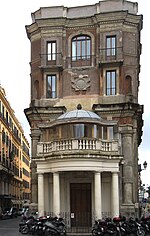Palazzo Zuccari
The Palazzo Zuccari in Rome is a narrow house between the two acute-angled streets Via Gregoriana and Via Sistina, which approach the Piazza della Trinita dei Monti near the church of Santa Trinità dei Monti . Today it houses an institute of the Max Planck Society .
history
The painter Federico Zuccari had the palazzo built as a residential and studio building from 1590 and painted the ground floor with frescoes. Zuccari also designed the portal to the adjoining garden, a mascherone , which has the shape of a face with a huge open mouth. Originally Zuccari wanted to bequeath the building to the artists of the Accademia di San Luca, which he founded . This did not happen because Zuccari left large debts after his death in 1609 and the building was unfinished.

From 1702, the Queen of Poland, Marie Casimire Louise de la Grange d'Arquien , lived in the building for a time and had a wooden arch built over Via Sistina and, presumably, Filippo Juvarra added a portico to the front .
Change of use
Later the Palazzo Zuccari was divided into apartments and mostly rented to foreigners and artists; Joshua Reynolds and Johann Joachim Winckelmann stayed there . One of the later owners, the Prussian Consul General Jakob Ludwig Salomon Bartholdy , had a corner room of his apartment (Casa Bartholdy) painted with scenes from the Joseph story in 1815. The frescoes by Peter von Cornelius , Friedrich Overbeck , Wilhelm von Schadow and Philipp Veit , which were sold by the Zuccari family to the Alte Nationalgalerie in Berlin in 1867 , are considered a major work of Nazarene art .
In 1904, the art collector and founder of today's Bibliotheca Hertziana , Henriette Hertz (1846–1913), bought the building and bequeathed it to the Kaiser Wilhelm Society in 1913 with the aim of establishing a research institute for art and cultural history. From 1943 the library and institute were relocated to Meran , Hallein and Saalfelden ; In 1944, the Allied military confiscated the palazzo. In 1953 the institute was handed over to the Max Planck Society and continued as the "Bibliotheca Hertziana (Max Planck Institute)". Today, the Palazzo Zuccari, together with the Palazzo Stroganoff , purchased in 1963 , the Villino Stroganoff and the new building by Juan Navarro Baldeweg opened in October 2012 , is one of the four buildings of the institute.
literature
- 100 years Bibliotheca Hertziana. , Volume 2: The Palazzo Zuccari and the institute buildings 1590–2013. Hirmer Verlag, Munich 2013, ISBN 978-3-7774-9041-0 .
- Lionel von Donop : The wall paintings in the Casa Bartholdy in the National Gallery . Berlin 1889, p. 6 f.
Web links
supporting documents
- ↑ On the residents of the palazzo see: Francesca Curti, Adel Künstler und Scheme. The owners and residents of Palazzo Zuccari (1660–1904), in: 100 Years of the Bibliotheca Hertziana. The Palazzo Zuccari and the institute buildings 1590–2013. Hirmer Verlag, Munich 2013, pp. 50–71.
- ^ Claudius Ziehr: Bibliotheca Hertziana ... Rome. In: Deutsche Bauzeitung . October 1, 2012, accessed December 19, 2015 .
Coordinates: 41 ° 54 ′ 20.4 ″ N , 12 ° 29 ′ 2 ″ E
